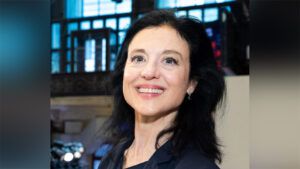French portfolio manager Ariane Mahler is on a roll. Two weeks ago, she rang the bell at the New York Stock Exchange to announce the launch of her fund’s new ETF and she is now back in San Francisco overseeing her portfolio. Here, the Veridien Global Investors’ CEO and CIO talks to ESG Clarity US about what prompted her to set up the firm in 2019, why her climate strategy has delivered 26.62% over the past three years and how she switches off.
Tell me about your personal journey to net zero. How did that start and how’s it going now?
When I became a portfolio manager I didn’t just have a good instinct for good companies, I was [also] pretty rigorous with valuation. I got to work very closely with CIOs at large institutions [but] none of these wonderful people…had much of an ESG conscience, much less an understanding of the climate crisis. It was doing a disservice to our investors.
It was really important [to me] to incorporate that knowledge of value investing in the climate space, which is arguably the most exciting space to be in for the long term. I realised this is going to deliver great returns if I can pick the right stocks at the right price.
Tell us about setting up the Veridien Climate Action ETF.
My background is institutional money management. How do you bring that skillset to a broader population and add an entry price that’s not a minimum $10m? Because we are a relatively new manager, we partnered with Tidal Toroso, which provides an ETF-in-a-box service and do all the operational aspects, and Praesidian Capital.
With the Praesidium wrapper, it’s a semi-transparent portfolio meaning holdings get released with a 60-day lag after quarter-end. With these two partners we were able to come to market as a smaller organization and bring an institutional-quality product to the general public. The stock is around $20 so it’s accessible to people that care about the climate but don’t have billions of dollars to invest.
It’s all about finding those companies that are reducing emissions around the globe, and that’s actually their mission. That’s not something they do on the side. It’s a very actively managed portfolio in the sense that we may or may not hold the company for very long. When we’ve put together a list of the companies we like – it might be just 100 stocks – we are actively watching what these stocks are doing, and sell when they reach our target price. Our goal is to beat asset management by hundreds of basis points a year.
How does this compare to a passive approach?
In the passive space, you’re buying the whole index. A lot of indices are calculated and include everything, regardless of price and whether or not it’s a good company. You’re just along for the ride. Frankly, investors must look at not just climate but also social issues and governance. If you don’t, you really are at risk of losing capital because this is an evolving, very subjective field. There are many mistakes that are still being made.
This game is about knowing more than everybody out there. That’s how I know I’m not overpaying or getting in at the peak. I figured I have to maintain a network of the top experts in all these fields, not just energy, it could be building construction. People always thought about coal plants or electric vehicles. That’s not even the bulk of our investments. What about semiconductors, forestry, agriculture, waste management? All these industries require a level of expertise that I’m always trying to make sure I’m on top of.
How do you switch off from climate investing?
Since I was a child, I’ve been in classical dance. I love it, I never get enough of it. One of my teachers said, “Beauty is what will save the world.” Once you realise how beautiful the world is, you want to do everything you can to save it. So ballet and asset management are the same thing for me: the search for perfection, truth and beauty.
